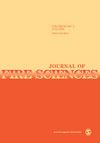环氧树脂涂层体系的材料尺度燃烧特性
IF 1.9
4区 工程技术
Q2 ENGINEERING, MULTIDISCIPLINARY
引用次数: 0
摘要
膨胀型涂料在材料范围内的易燃性“预计”会对其提供给钢构件的耐火性产生影响。然而,在暴露于熔炉中施加的火曲线的过程中,在多大程度上以及在什么阶段还没有完全确定。阻燃添加剂的不同功能在该过程中的作用也不清楚,尽管对其热分解机制有着深入的了解。为了更好地理解其中的一些方面,在这项工作中,选择了基于环氧树脂中不同阻燃添加剂的模型系统,以涵盖通常用于降低涂层系统可燃性的各种策略(如膨胀、自由基猝灭和吸热行为)。选择的阻燃添加剂是聚磷酸铵、四溴双酚A、9,10-二氢-9-氧杂-10-磷对映菲氧化物和氢氧化铝。研究了阻燃添加剂对环氧树脂固化、热分解和燃烧性能的影响。特别是,发现反应性阻燃添加剂可将与环氧树脂固化相关的焓降低45%以上。然而,尽管存在反应性阻燃添加剂,但由于这些配方中加入的硬化剂的量没有得到控制,这对环氧树脂/阻燃配方的热分解行为产生了负面影响,从而对计算的分解活化能产生了负面影响。加热速率似乎是影响配方可燃性的主要参数。通过将热解流动燃烧量热计中的加热速率从6°C/min更改为100°C/min,无论配方如何,峰值热释放速率值都增加了1382%-1970%以上。由于在高加热速率下每单位时间释放的易燃挥发物较高,因此在模拟纤维素燃烧曲线的熔炉测试中发生了涂层的点火和随后的燃烧。这对耐火时间产生了重大影响。本文章由计算机程序翻译,如有差异,请以英文原文为准。
Material-scale flammability characteristics of epoxy-based coating systems
Flammability of intumescent coatings at the materials-scale is “expected” to have an impact on their fire resistance offered to the steel member. However, to what extent and at what stage during the exposure to an imposed fire curve in a furnace are not thoroughly established. The role of different functionality of the flame-retardant additives in this process is also not clear despite a thorough understanding of their thermal decomposition mechanisms. In an effort to better understand some of these aspects, in this work, model systems based on different flame-retardant additives in epoxy are chosen to cover various strategies (like intumescent, radical quenching, and endothermic behavior) that are typically employed to reduce the flammability of a coating system. The flame-retardant additives chosen are ammonium polyphosphate, tetrabromobisphenol-A, 9,10-dihydro-9-oxa-10-phosphaphenanthrene oxide, and aluminum trihydroxide. The effects of flame-retardant additives on the curing, thermal decomposition, and flammability of epoxy resin are investigated. Reactive flame-retardant additives, in particular, are found to reduce the enthalpy associated with curing of epoxy by more than 45%. However, as the amount of hardener incorporated in these formulations is not controlled despite the presence of reactive flame-retardant additives, this had a negative effect on the thermal decomposition behavior of the epoxy/flame-retardant formulations, and consequently on the calculated decomposition activation energies. Heating rate seems to be a dominating parameter influencing the flammability of the formulations. Peak heat release rate values, irrespective of the formulation, increased by more than 1382%–1970% by changing the heating rate in a pyrolysis flow combustion calorimeter from 6°C/min to 100°C/min. As the flammable volatiles released per unit time are higher at high heating rates, ignition and subsequent flaming of the coating occurred in the furnace tests, where a cellulosic fire curve was simulated. This has significantly influenced the fire resistance times.
求助全文
通过发布文献求助,成功后即可免费获取论文全文。
去求助
来源期刊

Journal of Fire Sciences
工程技术-材料科学:综合
CiteScore
4.00
自引率
0.00%
发文量
14
审稿时长
2.5 months
期刊介绍:
The Journal of Fire Sciences is a leading journal for the reporting of significant fundamental and applied research that brings understanding of fire chemistry and fire physics to fire safety. Its content is aimed toward the prevention and mitigation of the adverse effects of fires involving combustible materials, as well as development of new tools to better address fire safety needs. The Journal of Fire Sciences covers experimental or theoretical studies of fire initiation and growth, flame retardant chemistry, fire physics relative to material behavior, fire containment, fire threat to people and the environment and fire safety engineering. This journal is a member of the Committee on Publication Ethics (COPE).
 求助内容:
求助内容: 应助结果提醒方式:
应助结果提醒方式:


